Learning How to Win in the Trenches with Aaron Donald

By the end of this season, it’s possible the Rams will have the best defense in football. Their front four, already the best in the league, will be the biggest reason for that ascension. And one lineman in particular will continue to stand out from the rest: Aaron Donald, the 13th overall pick in 2014. I had a chance to visit the future All-Pro this past summer.
After an early June OTA, a freshly showered Donald strolls into a meeting room at the Rams’ headquarters. The first thing I notice is that he’s really not that big at all. Listed at 6’ 1” and 285 pounds, he might even be considered “stocky” if not for how tightly his skin hugs his body. Wearing baggy camo shorts and a black T-shirt, he sets down his backpack and takes a seat at the table facing the big screen projection. He’d been described to me as a “quiet guy,” but conversing over film isn’t a problem.
We’re watching last year’s Week 7 home win over the Seahawks. Queued up is the Rams’ first defensive play of the game.
“I remember this play,” Donald says as he settles in.
He ought to. He exploded off the block, blowing past left guard James Carpenter and stuffing Marshawn Lynch at the line of scrimmage.
“It’s an ‘I’ formation, tight end on the line,” Donald says, pointing at each item on the screen. “It’s the first play of the game, they’ve got Lynch in the backfield, so I’m thinking run.”
The objective, he says, is to keep Carpenter “off the linebacker, but at the same time, try to split him. If you watch, his head is down the whole time. He’s coming down, his head’s low, so I’m going to get him with a step, and I’m going to swim, use my quickness and get down the line, trying to get Lynch.”
Carpenter finishes the play with his face in the turf.
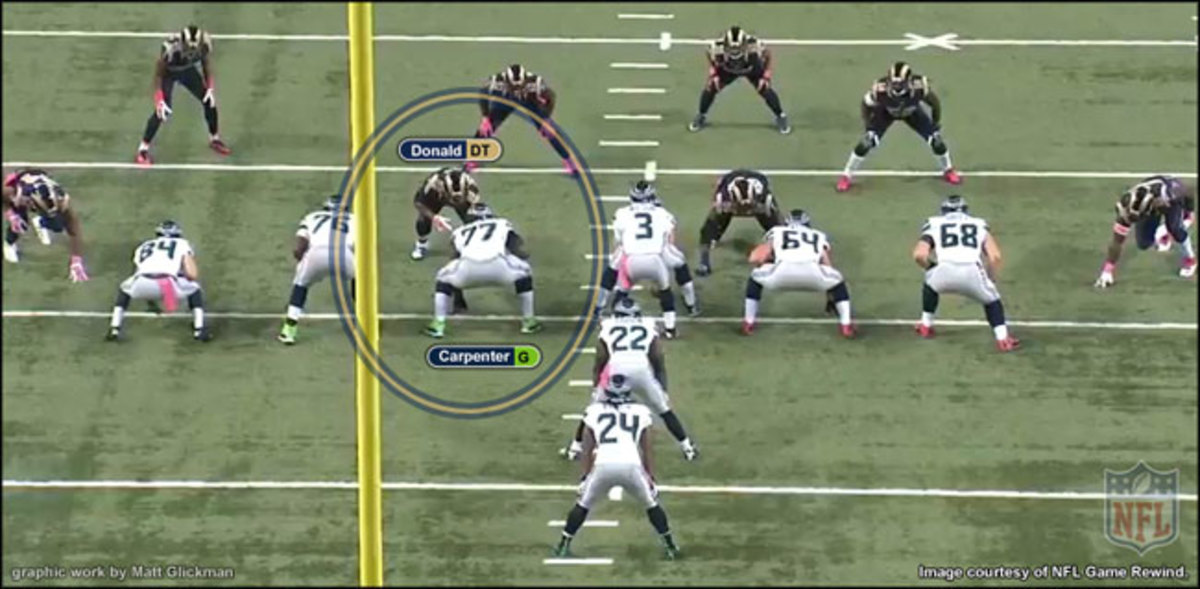
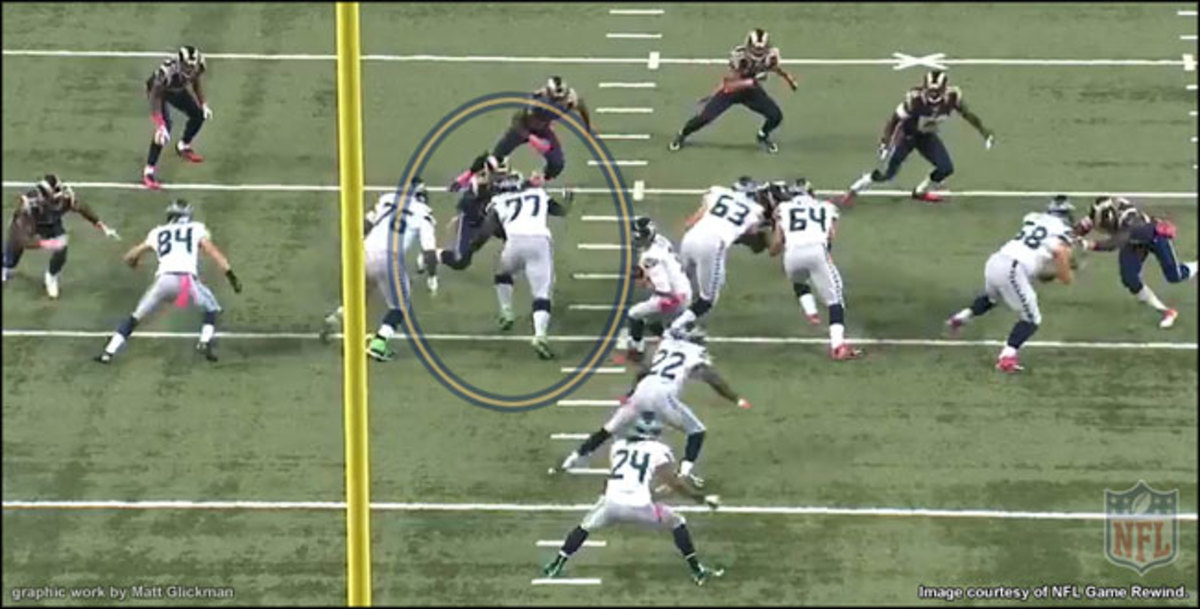
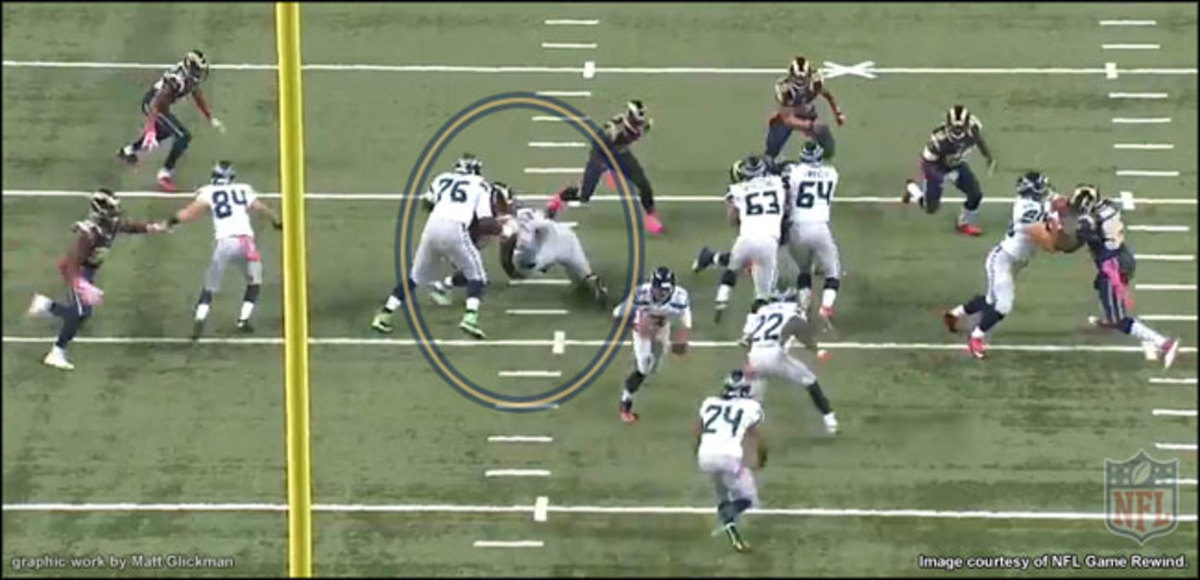
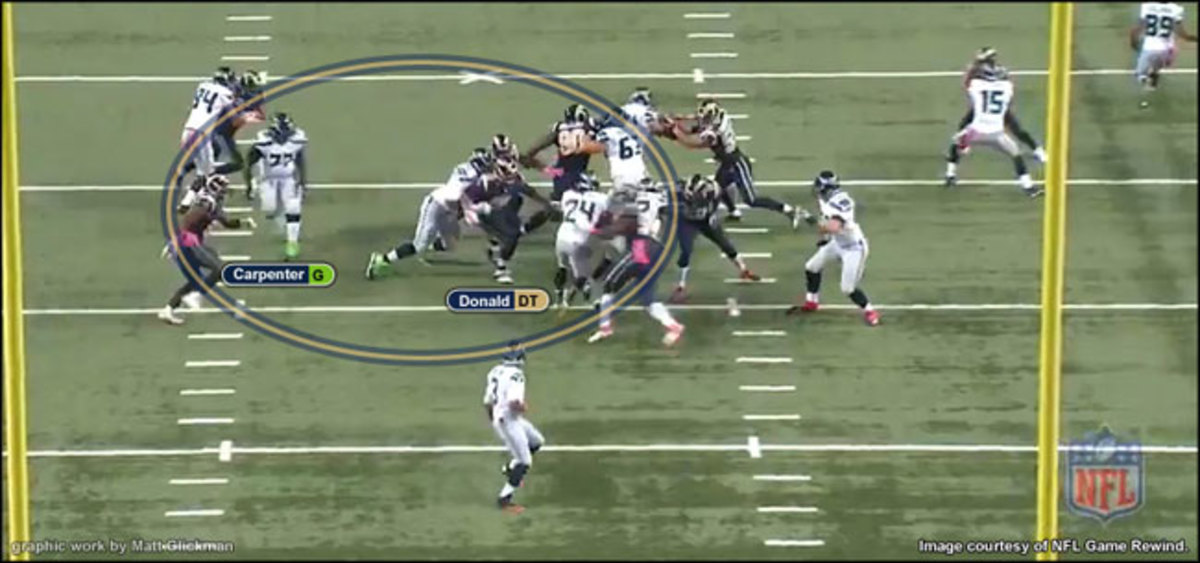
Three plays later, the Rams stuff Lynch again. But this time Donald is handled by right guard J.R. Sweezy—so soundly, in fact, that I thought maybe Donald was trying to clog multiple gaps rather than penetrate. Nope.
“We’re a get-off team; we’re a get-off defensive line,” he says. “Here it looks like I got off a little slow. [Sweezy] got out before me, he had a step on me . . . I have to try and hold my ground, hold my gap, so the linebacker can be free. I don’t want to get the linebackers confused by playing two gaps. This was me thinking too much, probably, and it slowed me down a step. But I held my gap, held my ground and still played physical.”
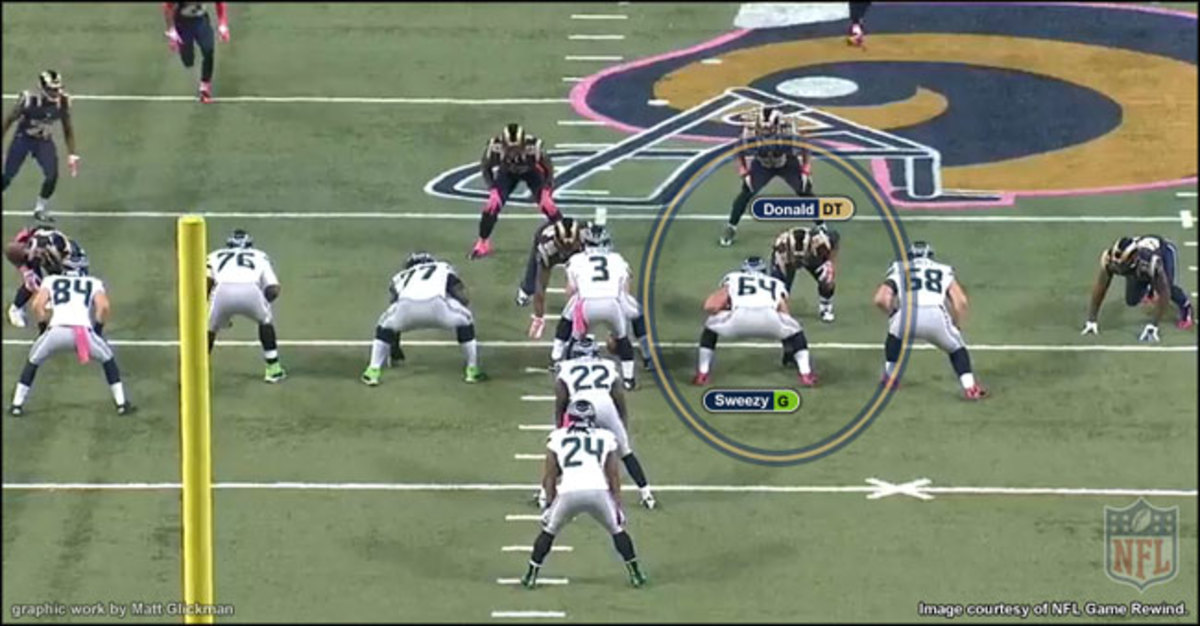
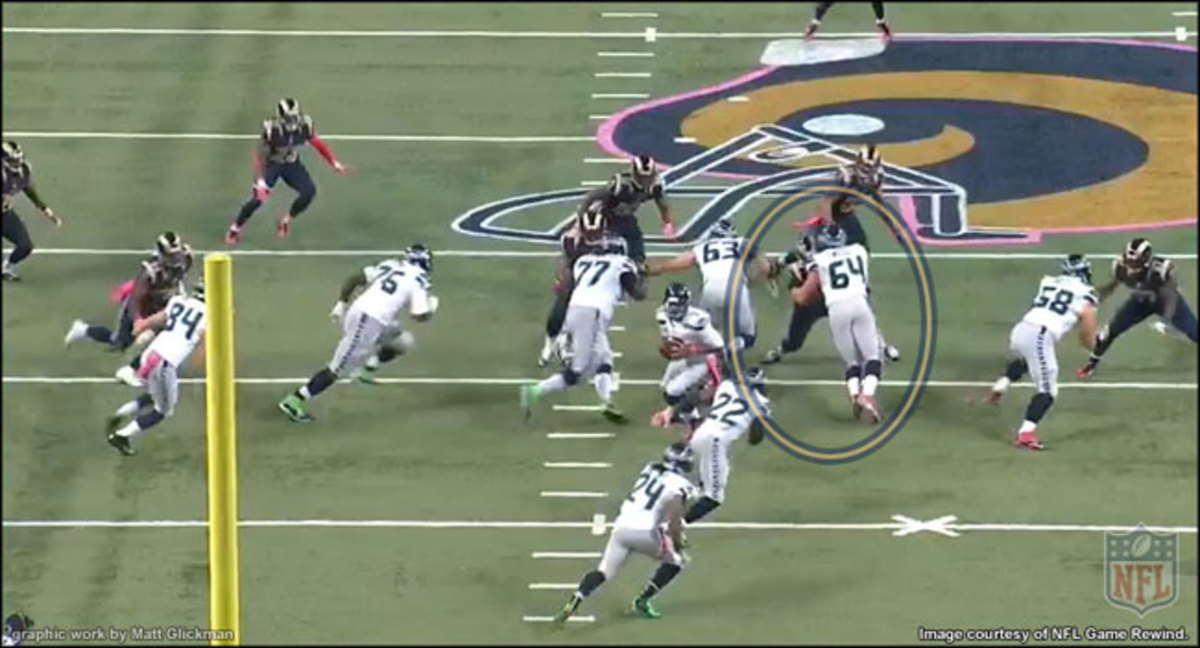
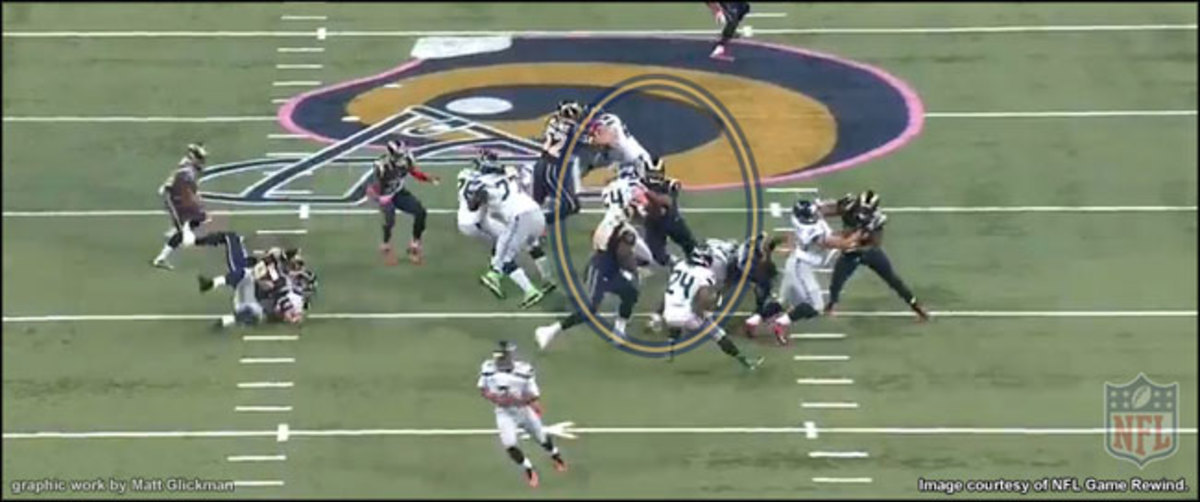
Despite Lynch’s being stuffed twice, Seattle marched down the field on the opening drive. On a red-zone play toward the end of it, Donald again exploded off the snap to get over the top of Carpenter. Lynch was compelled to bounce his zone run to the backside. Lynch is comfortable doing this, but the Rams were prepared. Just before the snap, Donald tapped his hip. “I’m letting the linebacker know I’ve heard his call and I’m doing what I’m called to do,” he says.
What he’s called to do is slant hard inside. This increases the likelihood of Lynch bouncing out to where the linebackers have scraped behind the D-line’s slant.
“I’m going to have to change up the tap signal now,” Donald says.
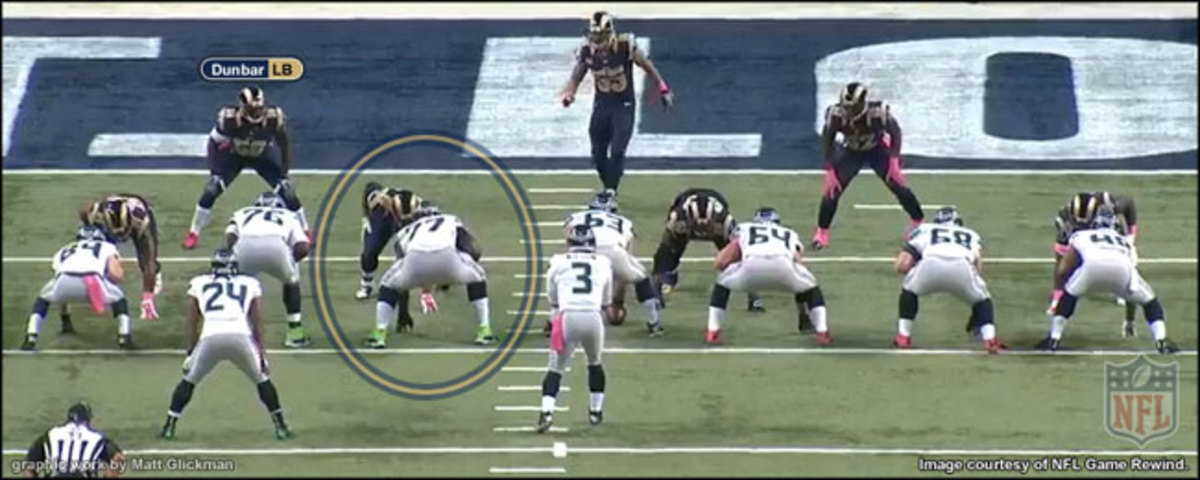
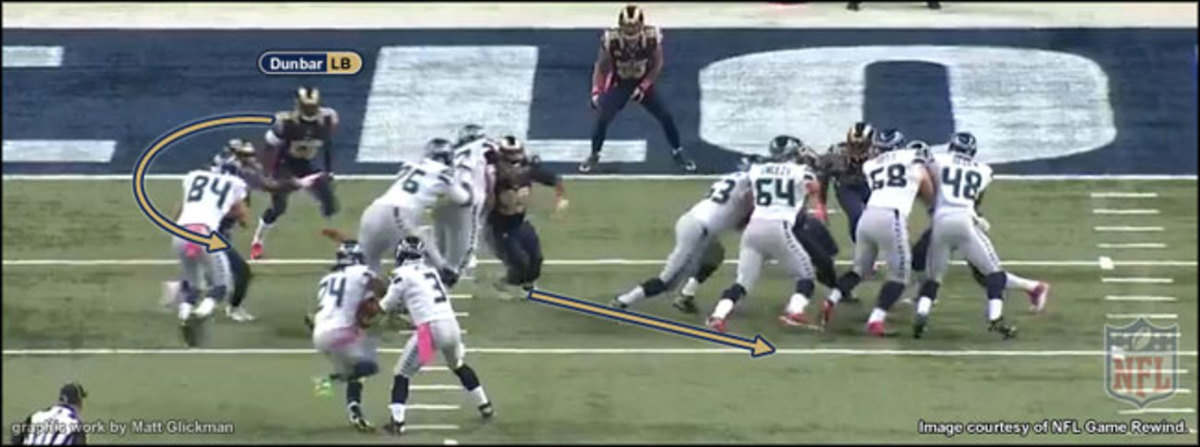

As we make our way through more plays, it’s apparent that Donald is markedly more athletic than Seattle’s guards. I wonder at what point he realized that.
“Watching film. They’re more of a finesse team, running sideways. I’m not the biggest defensive tackle, but I know I’m quick enough to shoot gaps and take advantage of stuff like that. So just going into the game I felt comfortable . . . a lot of teams in college do that sideways running, that zone stuff.”
So at what point in your film study did you realize that facing an outside zone-blocking line such as Seattle’s might be fun for a gap-shooter like yourself?
Donald chuckles. “Soon as you break down the first film and you see the other team having success.”
Donald’s athleticism also flashed against the pass. The first example came on a quick throw by Russell Wilson. It was a three-step drop completed to Doug Baldwin. But Donald still got a clean shot on Wilson after Carpenter passed him off to center Steven Schilling, who was occupied by the nose tackle.
This, frankly, was a baffling mistake by Carpenter, but Donald is polite in his analysis.
“Yeah, he’s thinking he’s going to get that center help, but we’ve got the center zeroed [i.e., covered up by a nose tackle], so if that center slides [to help] then our nose tackle’s right up the hash and getting the sack anyway. So it’s just a one-on-one, [Carpenter] probably just misplaced it.”
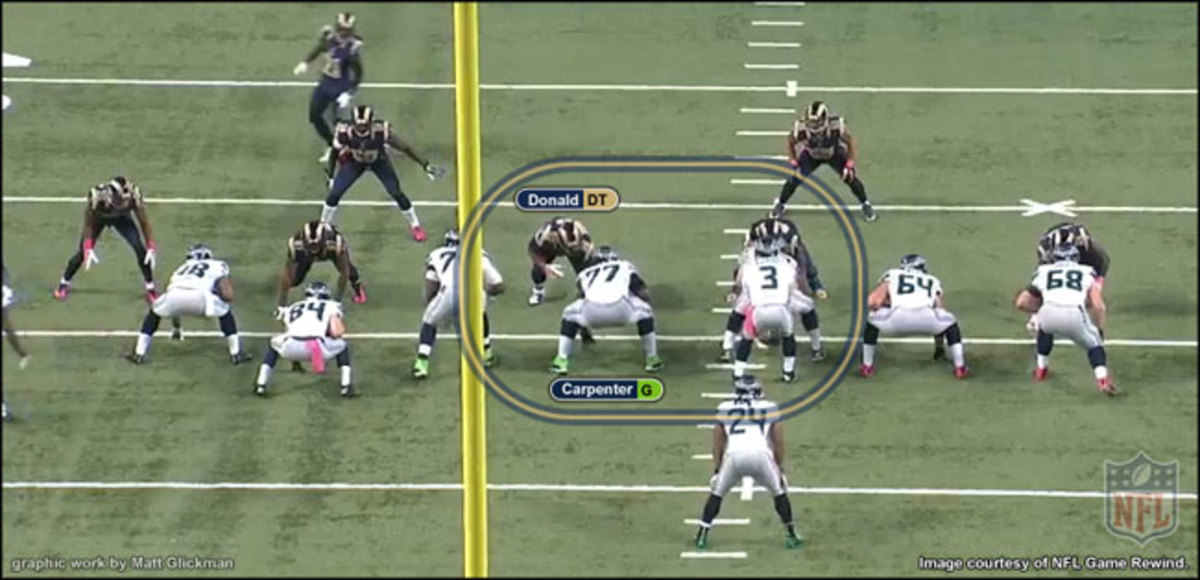
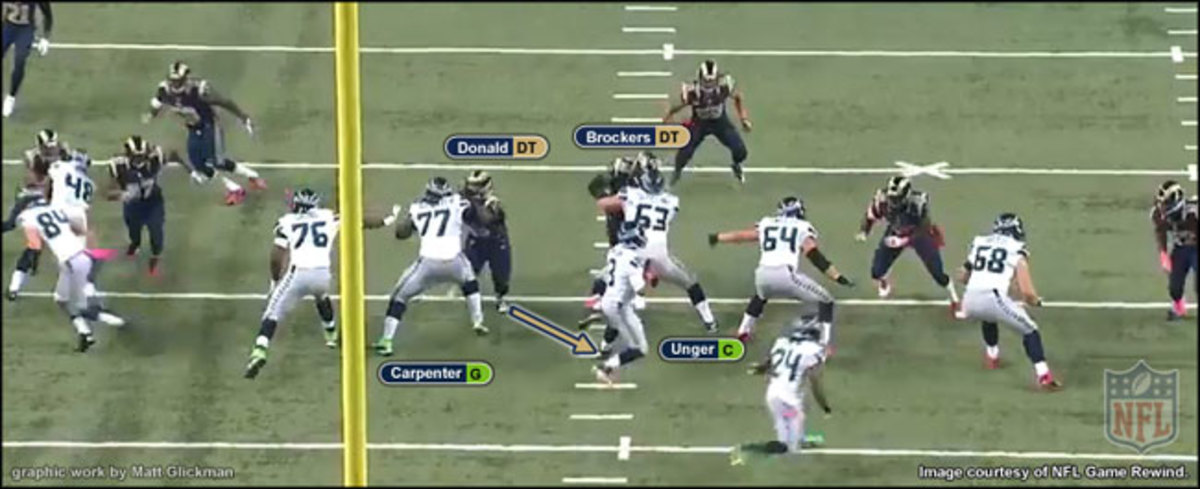
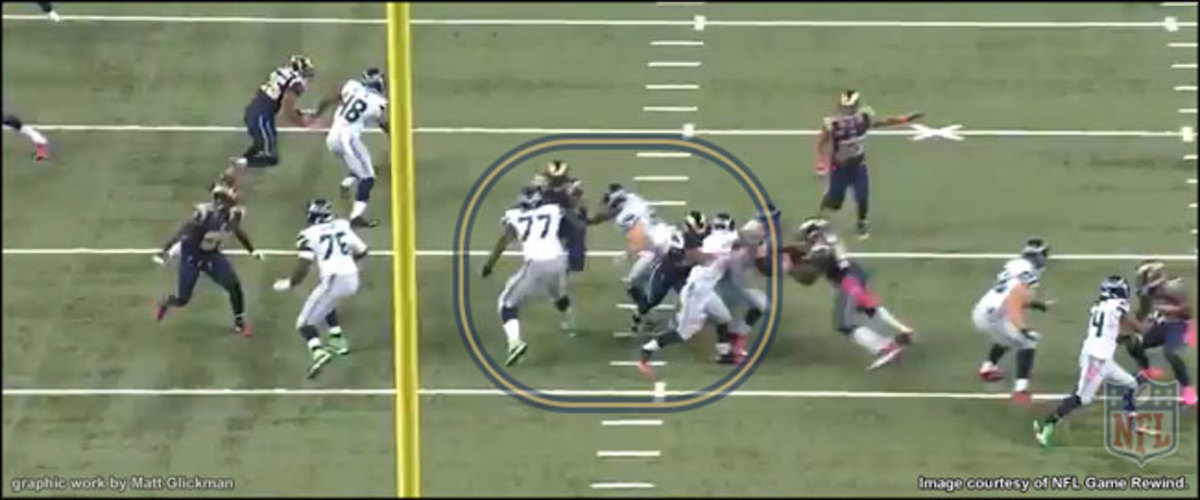
Later in the first half, we see almost the exact same defensive front. Again Carpenter passes Donald off. This time Schilling expected it and at least tried to help, but Michael Brockers, the nose tackle, did a superb job of occupying Schilling. Donald easily penetrated inside for a sack.
“I know I’m going to get that one-on-one here,” Donald says. “The center can’t slide and help the guard because he has to protect against that guy over the top of him [Brockers]. So I’ve got two ways that I can go. I can go B gap, or I can go A gap.”
Just as critical was the body language of the offensive linemen. Even though it was first down and there were tight ends outside both offensive tackles, Donald knew it was a pass. “If you look, everything is light up top,” Donald says, pointing the laser over each blocker, one by one. “Two-point stance, light, light, two-point. So you’re thinking pass already.”
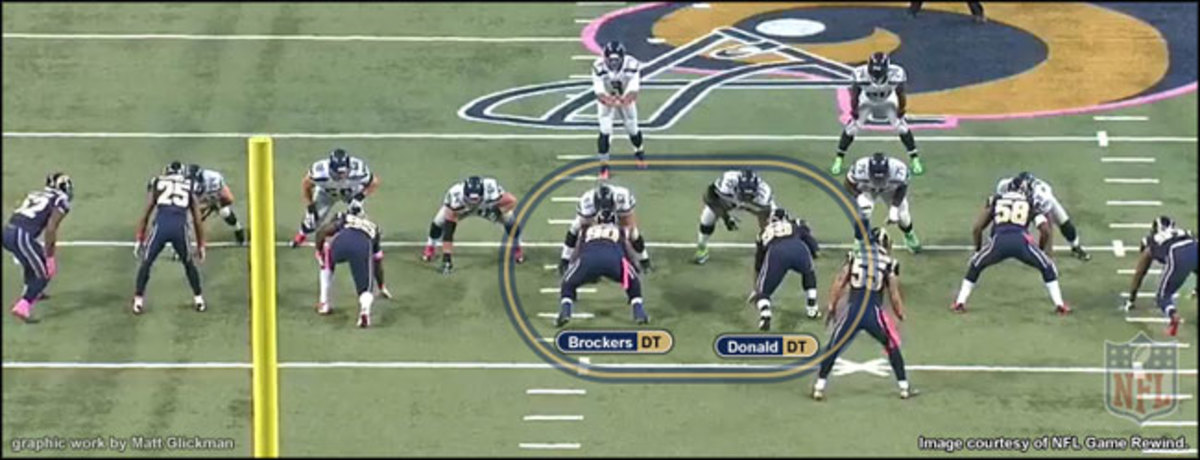
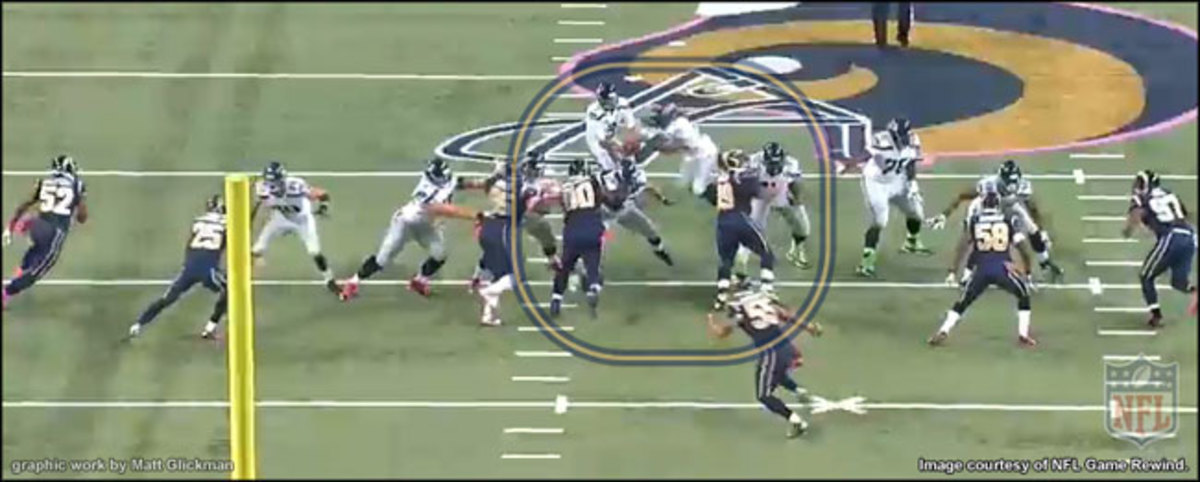
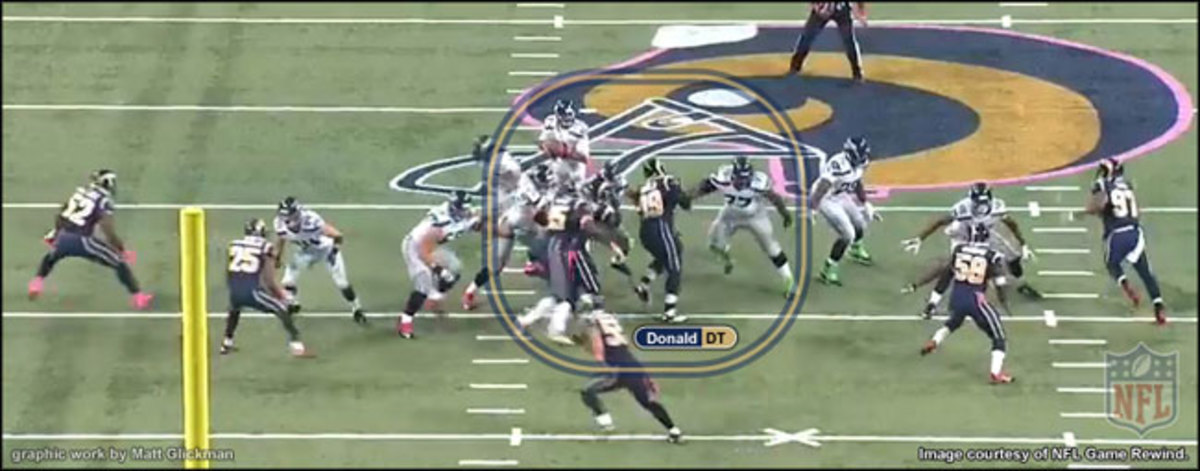
I go back to Brockers’s move at nose tackle. He masterfully attacked Schilling’s shoulder on the side away from Donald, which is why the center had no chance at sliding over to help the overmatched Carpenter. Did the rookie later buy the third-year veteran a nice dinner for this contribution?
“He’s just doing his job,” Donald says. “To me, he’s one of the top nose tackles in the NFL. He’s great at stopping the run and can rush the passer as well. He’s a big guy; we work together and we have success off each other.”
A few plays earlier, Donald had another opportunity for a one-on-one pass rush, against Sweezy on a third-and-12. But Sweezy won this battle.
“He got his hands inside, once you let somebody get hands inside, you lose,” Donald says. “I need better pad level. He’s lower than I am. I’m only 6-1, so sometimes I might pop up. I’m peeking at the quarterback. I should be worried about the guy in front of me. I should be working some type of move. I was going to go bull-rush, but I’m too high, so he got his hands inside.”
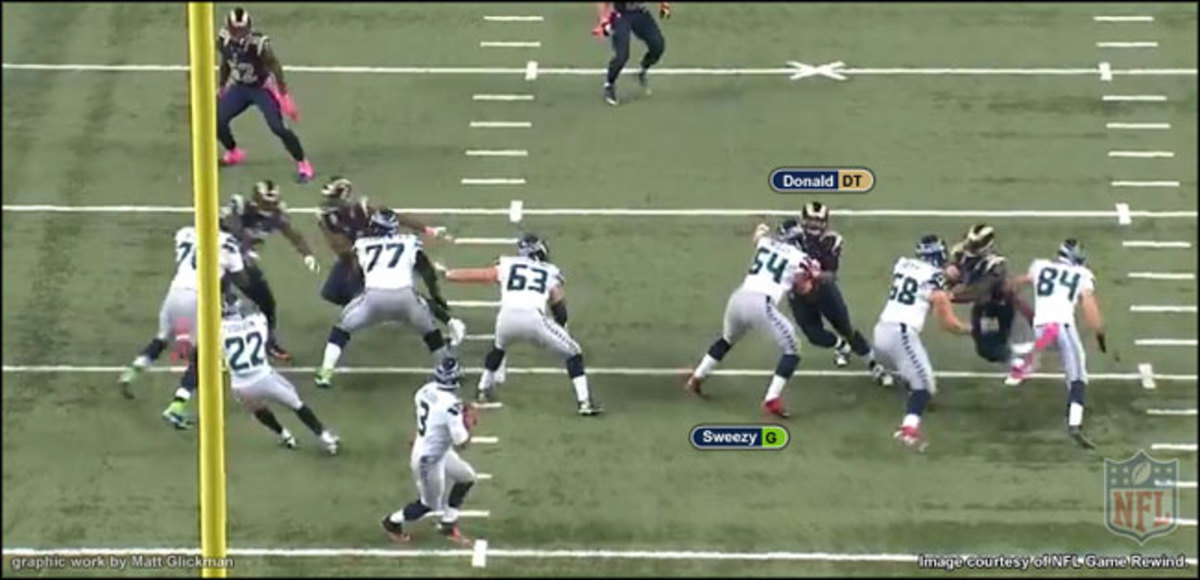
The hand-quickness of NFL offensive linemen is what Donald found the most jolting during his first season. The game we’re studying was just his second NFL start. He often lined up on the defensive right side, next to Robert Quinn, forming perhaps the most athletic outside-inside D-line pairing in football. But athleticism is irrelevant when guys don’t know where they’re going. There’s no better example than on Eugene Sims’s sack in the second quarter. Sims came from the defense’s left side—and it was a good thing. On the right side, Donald and Quinn collided and gradually fell like wobbly bowling pins.
On this particular play, third-and-14, Donald was at nose tackle, where he lines up in a few of St. Louis’s passing down sub-packages. “I’m not sure [what happened here], but it looks like Rob came down to my A gap. He probably was stunting [with safety Rodney McLeod, who was blitzing off the edge], so Rob has B gap to A gap. So I should have bull-rushed, that’s probably on me. Felt the momentum change, and I tried to get off it, thought I had him and then I bumped into Rob.”
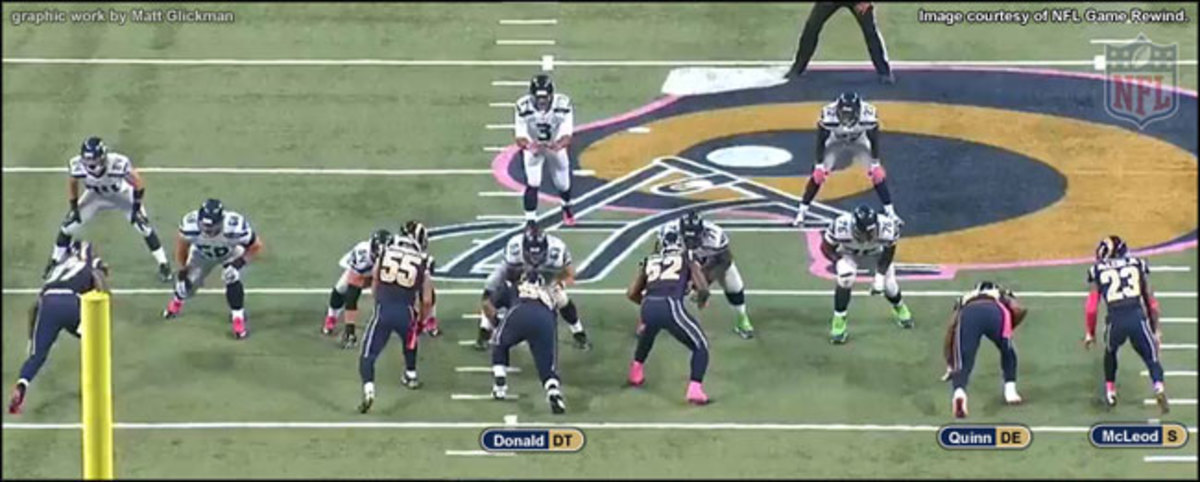
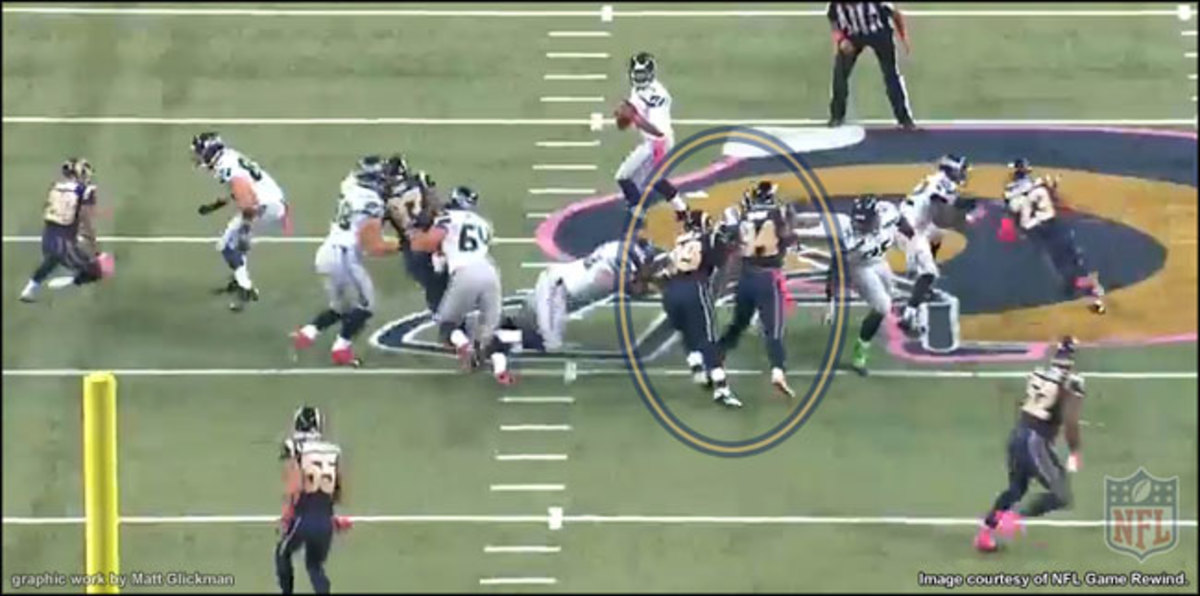
Donald doesn’t mind breaking down his negative plays, which is why I don’t mind bringing up another one on a pass rush near the end of the first half, when he widened too much and gave the 5’ 10” Russell Wilson a clear line of vision to hit tight end Cooper Helfet for 20 yards. If Wilson hadn’t thrown, he likely would have scrambled for a sizeable gain.
“I tried to hit Sweezy with a swipe. It just wasn’t a good move. For a low-hand guy, I should have chopped up.” Donald leans in to demonstrate. “So he’s punching like this”—he brings a soft fist into my vicinity—“I try to swipe. He’s a low-hand puncher. You use different pass rush moves for [the blockers’] different hand moves. You get higher hand blocking, you’re going to swipe; lower hand, you’re going to chop. I should have come with a chop.”
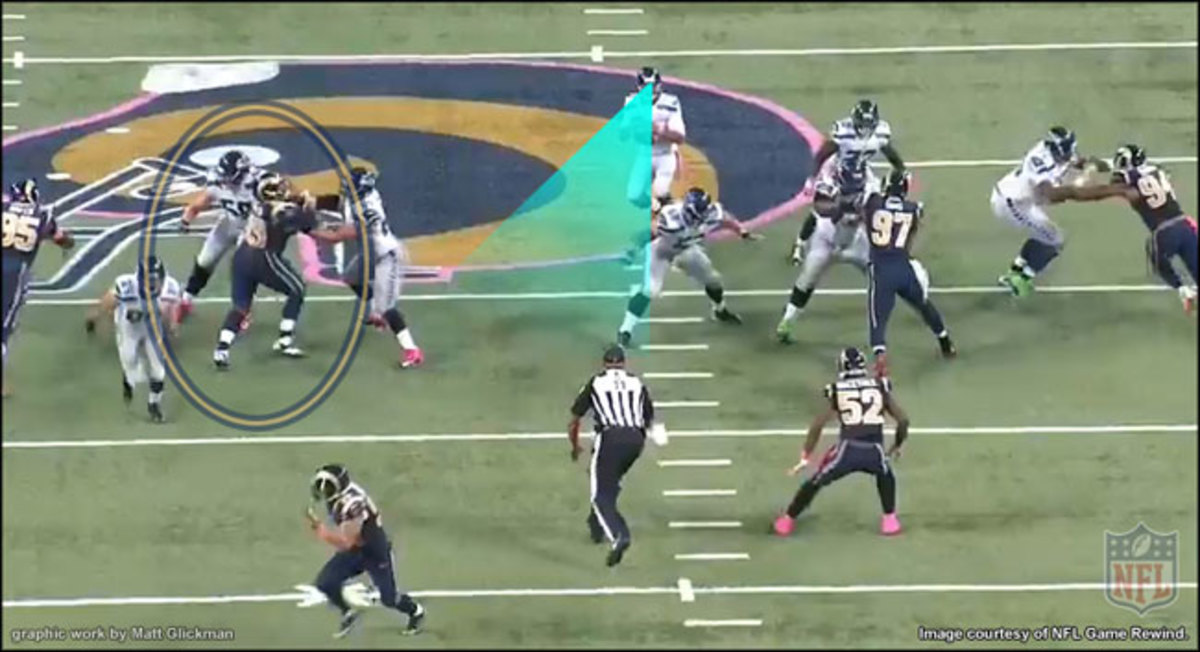
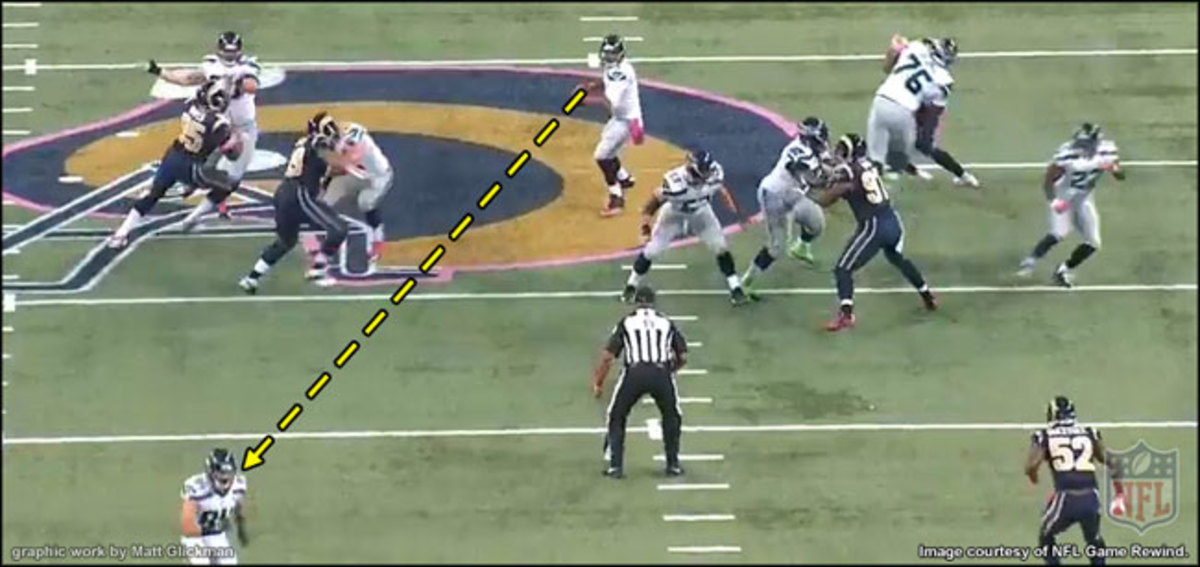
Four plays later, Donald atones for the error. On second-and-goal from the 12, with less than a minute remaining before halftime, he fires into the backfield and slams Lynch for a loss of five. The Seahawks are all but compelled to play for only a field goal, making Donald’s play a potential four-point swing.
“Like I said, they’re a finesse team, so they like to do a lot of zones. Obviously, they’re going to zone this way, right? Look at the splits.” Donald points to the space between Carpenter and left tackle Russell Okung. “They’ve got wider splits. It might not look wide, but it’s pretty wide.
“So I’m going to get in my stance, and I already know I can shoot that gap and try to cut it off, because I know if they’re going to zone it, they’re going to zone it right to me.”
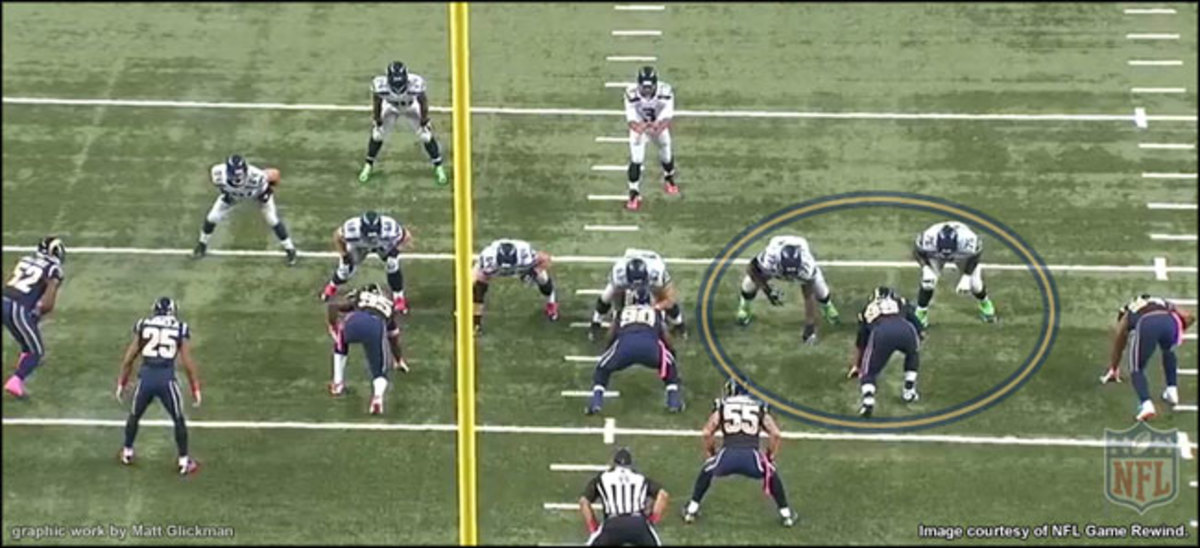
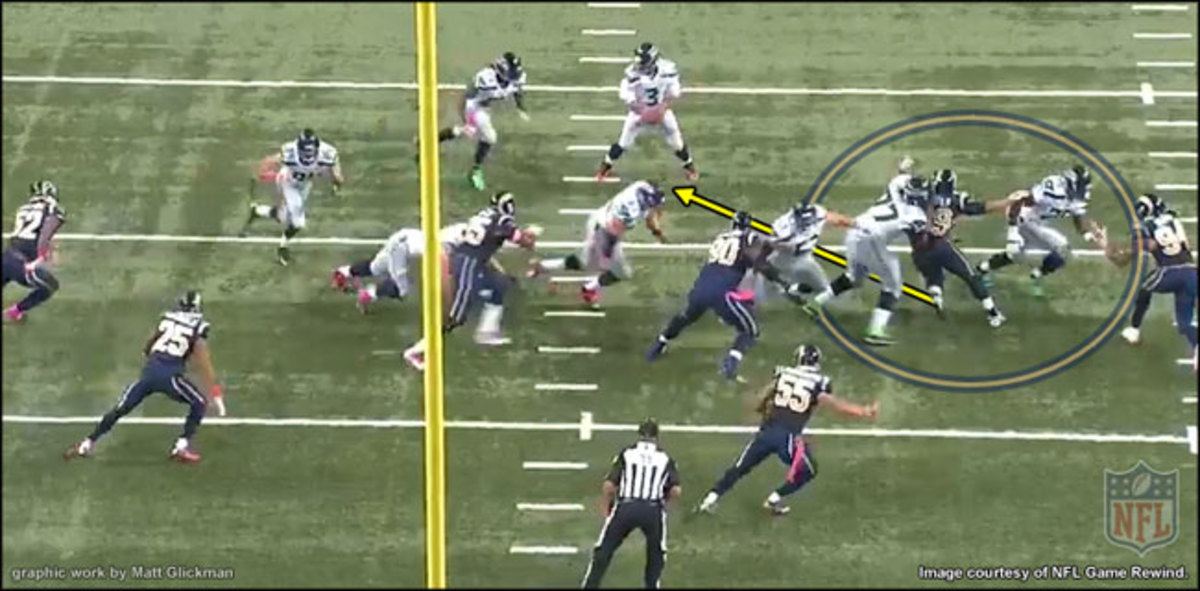
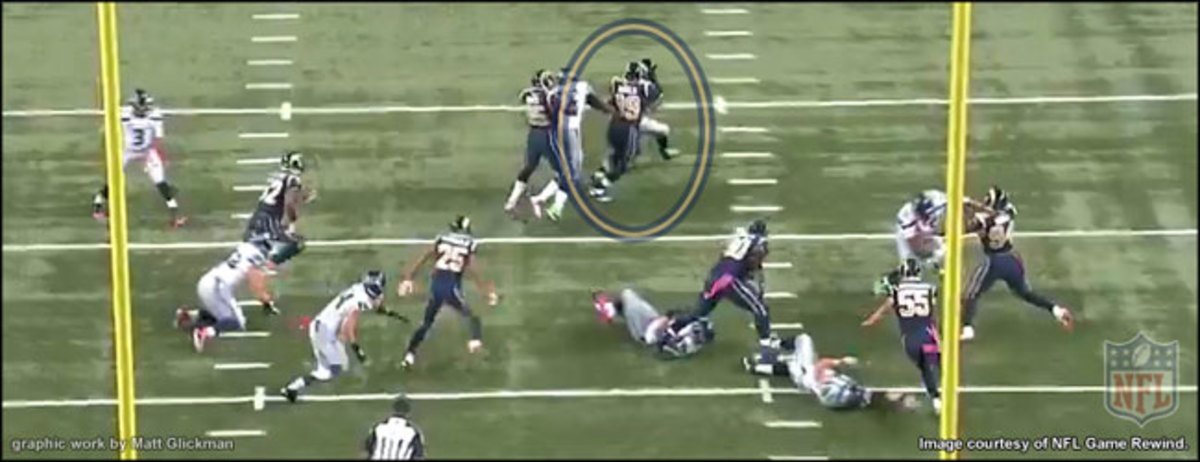
Throughout our session, Donald repeatedly goes back to a concept he calls “back-dooring.” Instead of going over the top of a moving blocker to get to the outside, a defender slips under or behind the blocker. It’s an extremely risky move for a linebacker, but a little more workable move for a D-lineman, particularly an athletic one playing with other great athletes around him. Still, if you’re going to go under a block, you’d better be right.
Donald brings up the back-door concept again on this tackle for a five-yard loss. When I mention how tough a job Carpenter had in the first place, moving across Donald’s body to seal him away from the zone run, he says, “He can get across my body, but if he does that and gets me, again, I’m going to backdoor, quick swim and get [the runner] in the backfield.”
Talented guys tend to have an answer for everything.
As the game progressed, Wilson, as he’s wont to do, relied more on his legs. There was one instance when Donald, who ran a 4.68 at the combine, was chasing the QB and gaining ground.
“I was moving. You just got to make sure with him, because he’ll turn back around, go the other way. You have to be watching him. You’ve got to play gap sound and rush in your lane, because he can throw the ball, he can roll out, he can throw the ball on the run, and if he takes off, he can take off.”
The Rams beat the Seahawks. A few weeks later, they welcomed the Broncos to their dome and beat them as well. I ask Donald, conceptually, whom he would rather play against: a big-time pocket passer such as Peyton Manning? Or a guy like Wilson, who is less structured but can move all over?
He responds after a significant pause. “If you play against a Peyton Manning, that’s a great quarterback, but I’d rather have that quarterback that stays still. You have a better chance of getting to him. The mobile quarterbacks, they do a lot of different stuff. [Offenses] can do more with a mobile quarterback, in my eyes.”
Early in the fourth quarter, Wilson illustrated this with a 52-yard scramble. On this play, Lynch put Quinn on the ground with a fantastic chip-block. After this win, did the Rams have fun the next day in the film room watching Quinn get taken out?
“Yeah. And soon as it happened, he said something about it.”
Then Donald adds, “I was mad on that play, ’cause I had Wilson. That guy can hurt you, man.”
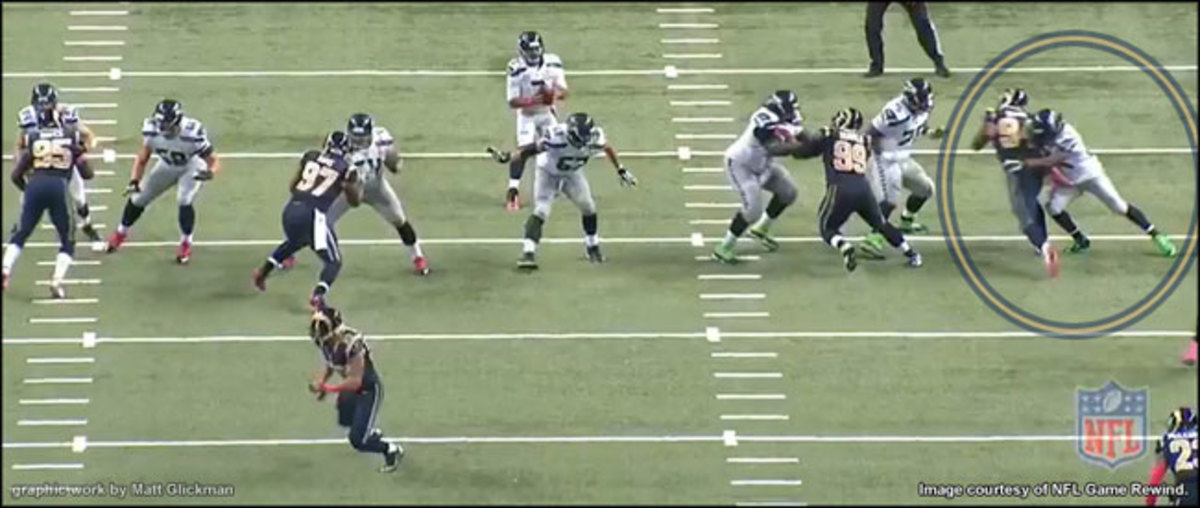
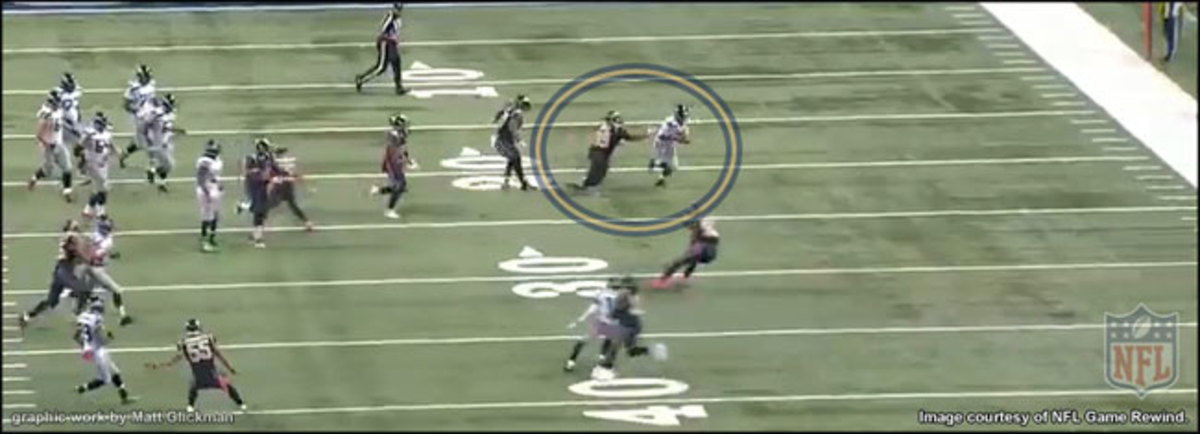
As this game wound down, Donald’s impact dissipated a bit. He acknowledges that he may have been feeling some fatigue. (Not atypical for a defensive lineman, especially one making his second start.) But the more I watch of Donald, and the more I watch with him, the more excited I become. This is the man who will soon supplant Gerald McCoy as the NFL’s top three-technique.
“I worked my butt off this offseason, I feel strong,” Donald says as we’re packing up to leave. “I am stronger. And faster. And I got a better feel for what’s going on out there.”
The proof has been overwhelming through the first four weeks of the season.
